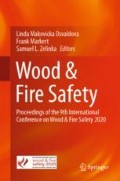Abstract
This work aimed at finding ways to improve the leaching resistance of Scots pine (Pinus sylvestris L.) wood impregnated with water soluble fire retardant (FR). Sapwood specimens of Scots pine (10 × 10 × 50 mm) were impregnated with aqueous solution of guanyl-urea phosphate (GUP)/boric acid (BA). Limiting oxygen index (LOI) revealed that treatment could improve the fire performance. At the same time, thermogravimetric analysis (TGA) illustrated increased thermal stability after the treatment. However, since the FR itself was not fixed within the wood cell wall, it was extracted during water leaching (EN 84), and the wood lost its fire retarding property. The resistance to leaching of FR from the treated wood can be primarily improved while maintaining high fire retarding performance and thermal stability of treated wood by mixing melamine-formaldehyde (MF) resin with GUP/BA before impregnation to the wood. To mix GUP/BA to MF solution, due to the acidic nature of GUP/BA, the condensation/polymerisation reaction would be accelerated in an undesired way even if the solution was adjusted to non-acidic by NaOH. The resulting solution would not penetrate deeply into the wood structure, whilst it would be difficult to re-use the FR solution. In order to avoid the reaction proceeding in an undesired way, introducing 0.5 wt% of pentaerythritol to the GUP/BA/MF solution can decrease the reaction rate. Additionally, it improved the weight percentage gain (WPG) and fire retarding performance, without significantly influencing the leaching resistance and thermal stability. Overall, it is suggested that such a treatment could be a suitable methodology for producing exterior-use fire-retardant pine wood.
Access this chapter
Tax calculation will be finalised at checkout
Purchases are for personal use only
References
Oberley WJ (1988) Non-resinous, uncured fire retardant and products produced therewith
Kawarasaki M, Hiradate R et al (2018) Fire retardancy of fire-retardant-impregnated wood after natural weathering I. Mokuzai Gakkaishi 64:105–114
Inoue M, Ogata S et al (1993) Dimensional stability, mechanical properties, and color changes of a low molecular weight melamine-formaldehyde resin impregnated wood. Mokuzai Gakkaishi 39:181–189
Deka M, Saikia C, Baruah K (2002) Studies on thermal degradation and termite resistant properties of chemically modified wood. Bioresour Technol 84:151–157
Xie Y, Xu J et al (2016) Thermo-oxidative decomposition and combustion behavior of scots pine (pinus sylvestris L.) sapwood modified with phenol- and melamine-formaldehyde resins. Wood Sci Technol 50:1125–1143
Wang B, Sheng H et al (2015) Recent advances for microencapsulation of flame retardant. Polym Degrad Stab 113:96–109
Chen Y, Wang Q (2007) Reaction of melamine phosphate with pentaerythritol and its products for flame retardation of polypropylene. Polym Adv Technol 18:587–600
Camino G, Costa L, Trossarelli L (1984) Study of the mechanism of intumescence in fire retardant polymers: part I-thermal degradation of ammonium polyphosphate-pentaerythritol mixtures. Polym Degrad Stab 6:243–252
Sun L, Qu Y, Li S (2012) Co-microencapsulate of ammonium polyphosphate and pentaerythritol and kinetics of its thermal degradation. Polym Degrad Stab 97:404–409
Wang Q, Li J, Winandy J (2004) Chemical mechanism of fire retardance of boric acid on wood. Wood Sci Technol 38:375–389
Anderson IH, Cawley M, Steedman W (1971) Melamine - formaldehyde resins II.-thermal degradation of model compounds and resins. Br Polym J 3:86–92
Wang Q, Li J, Li S (2006) Fire-retardant mechanism of fire-retardant FRW by FTIR. Front For China 1:438–444
Merline DJ, Vukusic S, Abdala AA (2013) Melamine formaldehyde: curing studies and reaction mechanism. Polym J 45:413–419
Fengel D (1989) Wegener G (1989) Wood: Chemistry, Ultrastructure, Reactions. Verlag Kessel, Remagen
Acknowledgements
Financial support from the Swedish Innovation Agency (Vinnova), project: “Swedish wood - Innovation potential for the bio-based society”, DP2: Needed processing of Swedish wood, 2017-02697, is greatly acknowledged.
Author information
Authors and Affiliations
Corresponding author
Editor information
Editors and Affiliations
Rights and permissions
Copyright information
© 2020 Springer Nature Switzerland AG
About this paper
Cite this paper
Lin, Cf., Karlsson, O., Mantanis, G.I., Jones, D., Sandberg, D. (2020). Fire Retardancy and Leaching Resistance of Pine Wood Impregnated with Melamine Formaldehyde Resin in-Situ with Guanyl-Urea Phosphate/Boric Acid. In: Makovicka Osvaldova, L., Markert, F., Zelinka, S. (eds) Wood & Fire Safety. WFS 2020. Springer, Cham. https://doi.org/10.1007/978-3-030-41235-7_12
Download citation
DOI: https://doi.org/10.1007/978-3-030-41235-7_12
Published:
Publisher Name: Springer, Cham
Print ISBN: 978-3-030-41234-0
Online ISBN: 978-3-030-41235-7
eBook Packages: EngineeringEngineering (R0)

